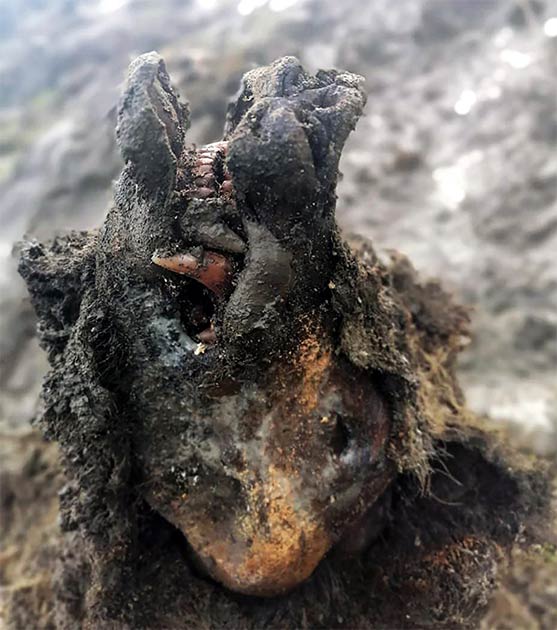The frozen wastes of Russia have long preserved ancient animals and have yielded many important Ice Age finds. Recently, reindeer herders came across a preserved Ice Age bear . This is the first adult Ice Age bear worldwide to be found in near perfect condition. This chance discovery is providing researchers with new insights into the Ice Age .
The frozen Ice Age bear body was found by indigenous reindeer herders on Bolshoy Lyakhovsky Island, the largest of the Lyakhovsky Islands. These desolate islands form part of the New Siberian Island Archipelago, located between the East Siberian Sea and the Laptev Sea. The island is within the Arctic Circle and many deposits of fossil ivory, mainly from mammoths, have been found on the Lyakhovsky Islands in the past. However, the discovery of the Ice Age bear is a first. Lena Grigorieva, a leading Russian expert on the Ice Age told The Siberian Times that “Today this is the first and only find of its kind – a whole bear carcass with soft tissues.”

The amazing head of the adult Ice Age bear as it was found. ( North-Eastern Federal University in Yakutsk (NEFU) )
Perfectly Frozen Ice Age Bear Is The First Ever, Anywhere!
Melting permafrost brought the bear to light, and its nose and teeth are still complete. The Guardian reports that “Previously, scientists only had been able to discover the bones of cave bears, that became extinct 15,000 years ago.” Researchers from the North-Eastern Federal University in Yakutsk believe that the Ice Age bear is between 22,000 and 35,000 years old. It has also been established that the specimen was a full-grown adult.
Lena Grigorieva is quoted by the Guardian as saying that “It is completely preserved, with all internal organs in place.” Previously, only bones of this type of bear have been found. The expert is quoted by CNN as saying that “This find is of great importance for the whole world.”
Ice Age Bears Are Better Known As Cave Bears
The cave bear was a species of bear that became extinct around 15,000 years ago due to climate change and other factors. It was named the cave bear because its remains have been mostly found in caves and it is believed that the bear spent a great deal of time in caves, and not just for hibernation. They were huge animals who lived mostly on vegetation, like their nearest living relative the Brown Bear. These Ice Age bears inhabited a huge area of northern Eurasia, and their bones have been found over an area ranging from central Europe to Siberia. CNN quotes Maxim Cheprasov, who works at the Mammoth Museum laboratory in Yakutsk: “It is necessary to carry out radiocarbon analysis to determine the precise age of the bear.”

This Ice Age bear cub was also found recently on the Yakutia mainland, not far from the adult find. ( North-Eastern Federal University in Yakutsk (NEFU) )
By coincidence, around the same time as the discovery on the Lyakhovsky Islands at “least one preserved carcass of a cave bear cub [was] found on the mainland of Yakutia,” reports The Siberian Times . It is believed that DNA can be extracted from the cub specimen. This discovery, along with the adult remains found on the Lyakhovsky Islands, will allow researchers to better understand the now extinct Ice Age bear and the people who hunted them.
Perfect Cave Bear Is Exposed, Thanks To Melting Permafrost
Research on the adult bear specimen, found on the island, is ongoing and overseen by the North-Eastern Federal University (NEFU) in Yakutsk, Siberia. The reindeer herders who made the discovery transferred the “right to research the specimen to the NEFU, which is at the forefront of research into extinct woolly mammoths and rhinos,” reports CNN. The researchers have not been able to physically visit the site where the Ice Age creature was found, which is a staggering 5000 miles (8047 km) from Moscow.
As the planet warms the permafrost is slowly melting in the far north of Russia and Canada. In recent years, many remains of mammoths, dogs, woolly rhinos , extinct horses, and cave lions have been discovered by indigenous people or researchers. New scientific research technologies, such as DNA analysis , are providing new insights into both Ice Age creatures and people. In fact, some researchers hope that DNA technology can be used to bring the extinct mammoth and other ancient creatures back to life.
Top image: The perfectly preserved snout of the adult Ice Age bear recently found in Russia. Source: North-Eastern Federal University in Yakutsk (NEFU)
By Ed Whelan
Related posts:
Views: 0
 RSS Feed
RSS Feed

















 September 16th, 2020
September 16th, 2020  Awake Goy
Awake Goy  Posted in
Posted in  Tags:
Tags: 
















